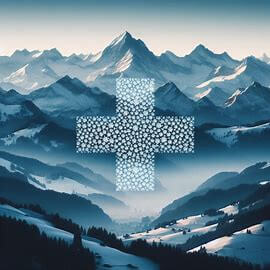The flag of Switzerland consists of a square red field with a white cross in the center. This unique and instantly recognizable design is one of only two square national flags in the world (the other being Vatican City).
Switzerland information
| National Flag Day | August 1 |
| Sovereign state | Yes |
| Official name | Swiss Confederation |
| Capital | Bern |
| Population | 8,507,000 |
| Area | 41,290 km² |
| Currency | Swiss franc (CHF) |
| Language | German, French, Italian, Romansh |
| Continent | Europe |
| Region | Western Europe |
| Subregion | — |
| Borders | Austria, France, Germany, Italy, Liechtenstein |
| Timezone | Central European Time (CET) UTC+1 |
| Calling code | +41 |
| Top-level domain | .ch |
History of the Swiss Flag
 The origins of the Swiss flag date back to the 13th century, making it one of the oldest national flags in the world. The current design was officially adopted on December 12, 1889, although it had been used unofficially for centuries before. The white cross on a red field was originally a symbol used by the Old Swiss Confederacy during medieval times.
The origins of the Swiss flag date back to the 13th century, making it one of the oldest national flags in the world. The current design was officially adopted on December 12, 1889, although it had been used unofficially for centuries before. The white cross on a red field was originally a symbol used by the Old Swiss Confederacy during medieval times.
Symbolism and Design of the Swiss Flag
The Swiss flag's design carries deep symbolic meaning:
- The red field symbolizes the blood shed by Swiss patriots in defense of their land and liberty.
- The white cross represents Christianity, as well as the values of freedom, justice, and peace that Switzerland upholds.
- The square shape is unique among national flags and is said to represent the stability and balance of Swiss society.
Usage and Significance of the Swiss Flag
 The Swiss flag is a powerful symbol of national identity and unity. It is displayed on government buildings, during national celebrations such as Swiss National Day on August 1, and at international events. The flag represents Switzerland's long-standing traditions of neutrality, democracy, and humanitarian values.
The Swiss flag is a powerful symbol of national identity and unity. It is displayed on government buildings, during national celebrations such as Swiss National Day on August 1, and at international events. The flag represents Switzerland's long-standing traditions of neutrality, democracy, and humanitarian values.
Interesting Facts About the Swiss Flag
- The Swiss flag is the only square national flag among UN member states.
- The proportions and design of the Swiss flag are precisely defined by law.
- The Swiss cross is also used as a symbol for Swiss-made products, representing quality and precision.
- In a naval context, Switzerland uses a rectangular version of the flag as an ensign, despite being a landlocked country.